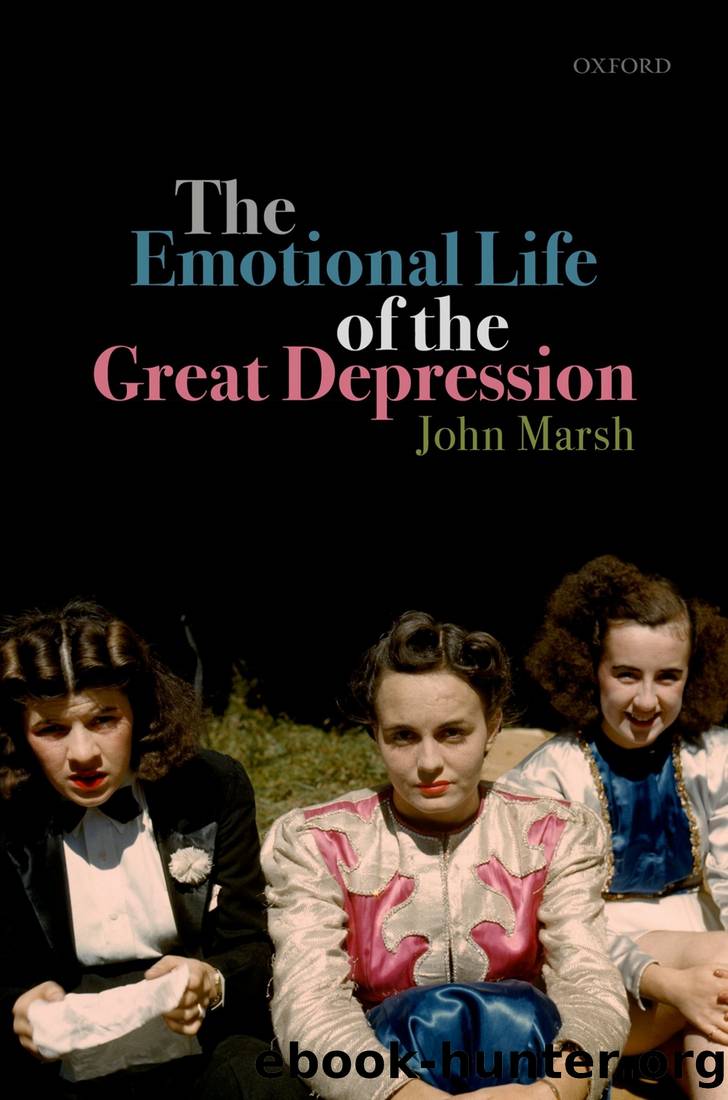The Emotional Life of the Great Depression by Marsh John;

Author:Marsh, John; [Marsh, John]
Language: eng
Format: epub
ISBN: 9780198847731
Publisher: OxfordUP
Published: 2019-09-28T00:00:00+00:00
That intimacy, which evidently included Buckingham Palace itself, would not have âengaged Mayfair,â or not to the extent that it did, if not for the fact that Mrs. Simpson remained marriedâto a London shipbroker named Ernest Simpsonâand, as the article also reported, in passing but portentously, that Mrs. Simpson had married and divorced before marrying Simpson. In short, if Mayfair was engagedâand it was far from aloneâit was because the King of England had taken up with a once-divorced, still-married American woman.
Mayfair and elsewhere paid still more attention when, on October 14, the Associated Press reported that Wallis Simpson had filed for divorce from her husband on grounds of adultery.2 Journalists immediately began to speculate whether the impending divorce meant that Edward would marry Wallis. On October 26, an article credited âfriends of the Kingâ with saying âthat he is deeply and sincerely in love with Mrs. Simpsonâ and intended to marry her in the spring, which he could, in theory, since on October 27 an English judge granted Wallisâs divorce, which would free her to remarry six months from the day.3
The friends of the king knew their man. On November 16, Edward privately summoned prime minister Stanley Baldwin to Buckingham Palace and informed him of his wish to marry Simpson following his official coronation in May 1937. Baldwin told the king that the British people would never accept the marriage.4 As the coming weeks revealed, the British elite did not thrill to it either. Members of the royal family, including and especially Queen Mary, Edwardâs mother, thought Wallis a temptress, a gold-digger, or just plain common. For its part, the still influential Church of England disapproved of the marriage too. It did not allow those who divorced to remarry while the former spouse lived, which Ernest Simpson very much did. Nor did Britain recognize Wallisâs first divorce, obtained in the United States, as legitimate since it dissolved because of âemotional incompatiblyâ instead of adultery. (Under British law, only adultery counted as grounds for divorce.) Technically, then, Wallis had already committed bigamy by marrying Ernest Simpson, her second husband, and would again if she married the king. The Church of England, needless to say, did not condone bigamy. Finally, some members of the British government, including the prime minister, suspected that Simpsonâand Edward, for that matter, which did not burnish his qualifications as kingâmight be Nazi sympathizers. For these reasons, Baldwin and most of those who mattered opposed the marriage, and the prime minister flatly told Edward that if he proceeded with marrying Wallis, Edward would, for obscure legislative reasons, force the existing government to resign and prompt a dangerous constitutional crisis.5
Faced with this possibility, Edward chose to give up the throne and marry the woman he loved. On December 10, 1936 he formally abdicated, turning the kingdom over to his brother, Albert, who became George VI. The next day, Edward addressed the country over the radio. His speech would soon appear on the front pages of newspapers across the world.
Download
This site does not store any files on its server. We only index and link to content provided by other sites. Please contact the content providers to delete copyright contents if any and email us, we'll remove relevant links or contents immediately.
The Power of Myth by Joseph Campbell & Bill Moyers(925)
Half Moon Bay by Jonathan Kellerman & Jesse Kellerman(911)
A Social History of the Media by Peter Burke & Peter Burke(882)
Inseparable by Emma Donoghue(844)
The Nets of Modernism: Henry James, Virginia Woolf, James Joyce, and Sigmund Freud by Maud Ellmann(739)
The Spike by Mark Humphries;(719)
A Theory of Narrative Drawing by Simon Grennan(707)
The Complete Correspondence 1928-1940 by Theodor W. Adorno & Walter Benjamin(704)
Ideology by Eagleton Terry;(659)
Bodies from the Library 3 by Tony Medawar(649)
Culture by Terry Eagleton(646)
World Philology by(645)
Farnsworth's Classical English Rhetoric by Ward Farnsworth(641)
A Reader’s Companion to J. D. Salinger’s The Catcher in the Rye by Peter Beidler(614)
Adam Smith by Jonathan Conlin(608)
High Albania by M. Edith Durham(592)
Game of Thrones and Philosophy by William Irwin(592)
Comic Genius: Portraits of Funny People by(581)
Monkey King by Wu Cheng'en(577)
